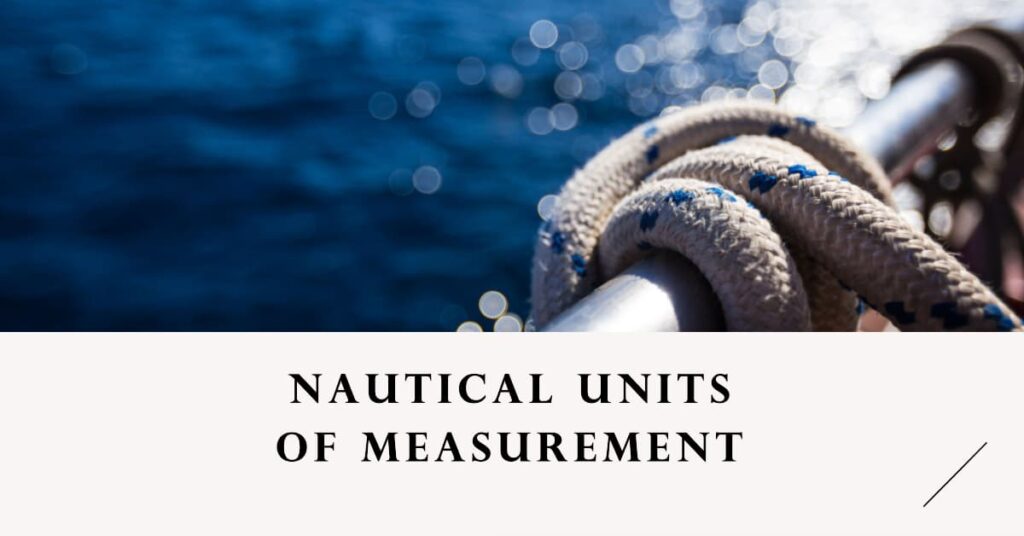Embrace the salty spray and the sway of the ship as we delve into the intricacies of ‘nautical units of measurement’. Unfurl the sails of knowledge and set a course on a journey that explores the unique lexicon of the maritime world.
Whether you’re an old sea dog or a landlubber, you’ll find a treasure trove of insights as we navigate the nautical miles, fathoms, knots, and more.

Navigating the open sea is quite unlike cruising down a city street. It demands a unique set of distance units that are tailored to the complexities of marine travel. The most commonly used of these is the Nautical Mile. One nautical mile, or NM, is equivalent to one minute of latitude, translating to roughly 1.1508 statute miles or 1.852 kilometers. When you’re traversing the expansive blue of the Pacific, this is your bread-and-butter for measuring distance.
Beyond nautical miles, mariners also use a variety of other distance measurements. The League, an age-old nautical unit, is generally taken to mean three nautical miles, or roughly 3.452 miles (5.556 kilometers).
The Furlong, another obsolete nautical unit of distance, is equal to one-eighth of a statute mile or roughly 220 yards (201.17 meters). But, for more immediate distances, we have the Cable (cbl), which measures a tenth of a nautical mile, or about 608 feet (185.3 meters).
And last but not least, there’s the Shackle. If you’ve ever wondered about how long a ship’s anchor chain is, it’s often measured in shackles, with each shackle representing 15 fathoms, 90 feet, or 27.432 meters.
Finding Our Place: Latitude and Longitude
In the vast, markerless expanse of the ocean, the nautical units of measurement for a position are critical. Latitude and Longitude form the backbone of these systems, telling us our north-south and east-west position respectively.
Latitude: Your North-South Coordinate
Latitude measures your position in a north-south direction from the Earth’s equator, which is the 0-degree line. This invisible line wraps around the center of the Earth, neatly dividing it into the Northern and Southern Hemispheres. As you move further away from the equator, either towards the North Pole or the South Pole, your latitude increases. The maximum latitude is 90 degrees, whether you’re heading towards the North Pole or South Pole.
Imagine you’re on a sailing expedition in the tropical seas, somewhere near the equator, basking under the warm sun. As you journey further north, you notice a gradual drop in temperature. This is because you’re increasing your latitude, moving away from the zero-degree warmth of the equator and inching closer towards the higher latitudes of the chilly north.
Longitude: Your East-West Coordinate
On the other hand, Longitude measures your position in an east-west direction from a fixed point known as the Prime Meridian. The Prime Meridian, defined as 0 degrees, passes through Greenwich, London, in the United Kingdom. From there, the lines of longitude extend towards the east and west up to 180 degrees.
Let’s say you’re setting sail from Greenwich, heading east. As you travel, you’ll notice the sun rising earlier each day. That’s because you’re increasing your longitude, moving through different time zones. By understanding and tracking longitude, sailors can accurately determine local time and maintain their internal clocks.
Picking up Speed: Understanding the Knot
In the vast expanse of the ocean, speed takes on a different dimension. On land, we typically measure speed in miles per hour or kilometers per hour. But when you’re cutting through the waves, your speed is measured in a unique nautical unit of speed measurement called the Knot.
The Knot: A Nautical Mile per Hour
At its most basic, a knot is equivalent to one nautical mile per hour. While this may seem similar to the land-based miles per hour, there is a crucial difference. A nautical mile is based on the circumference of the earth and corresponds to one minute of latitude. As such, it’s a bit longer than the standard mile, coming in at approximately 1.1508 statute miles, or about 1.852 kilometers.
So why does this matter? Well, when you’re navigating the high seas, using nautical miles—and by extension knots—aligns with the global positioning system of latitude and longitude. This consistency allows for more accurate navigation and helps ensure safe and efficient sea voyages.
Knots in Action
To visualize this, imagine you’re the captain of a sailing vessel. Your destination is 100 nautical miles away. If you sail at a consistent speed of 10 knots, you’d expect to reach your destination in about 10 hours.
However, if you were to measure your speed in miles per hour, using standard miles instead of nautical miles, you’d end up slightly off course. Your calculations for arrival time and fuel consumption would be skewed, which in the world of seafaring could lead to serious consequences.
For an in-depth look at this unique unit of speed, make sure to visit our detailed guide on how fast is a knot.
The Beauty of Knots
Knots bind the seafaring world together. They’re a testament to the rich history and unique challenges of maritime navigation, encapsulating the essence of nautical units of measurement. Understanding knots not only equips us with practical knowledge for sea navigation but also invites us into a deeper appreciation of the subtle intricacies that set the maritime world apart.
Whether you’re charting a transoceanic journey or simply fascinated by the language of the sea, grasping the concept of the knot brings you one step closer to the heart of maritime navigation.
Charting Our Path: Heading, Course, Bearing, and Rhumb
Taking the helm of a vessel, be it a yacht or a massive cargo ship, requires more than just knowing where you are. You need to understand where you’re heading, what your course is, and how to navigate towards your destination. In the world of navigation, these concepts are encapsulated in four key terms: Heading, Course, Bearing, and Rhumb.
Heading: The Direction You’re Facing
When you’re standing at the helm, looking forward, the direction straight ahead of you is your Heading. This is the direction in which your vessel’s bow is pointing at any given moment, expressed in degrees from 0 to 360, usually relative to true or magnetic north.
Picture yourself steering a boat on a calm lake, aiming straight for a distant lighthouse. Your heading is the direct line from your boat to that lighthouse. However, remember that the heading doesn’t always reflect the boat’s actual path, especially if currents or winds push your boat sideways.
Course: Your Intended Direction
While the heading is the direction your vessel is pointing, the Course is the intended path you want to travel, again expressed in degrees from north. It’s the direction you plan to steer the boat.
Let’s return to the scenario of crossing the lake towards the lighthouse. If a strong wind starts pushing your boat off to the side, you might have to adjust your heading to maintain your course towards the lighthouse.
Bearing: Angle to Your Destination
Next comes the Bearing, which is the angle between the line from your position to your destination and the line from your position to the north.
So, if you’re on the lake and the lighthouse is due east, the bearing to the lighthouse is 90 degrees. Bearings help you orient yourself in relation to your surroundings and are vital for plotting your course and heading accurately.
Rhumb: A Steady Angle
Finally, we have the Rhumb, sometimes known as rhumb line or loxodrome. This is a line on the surface of the Earth that cuts all meridians at the same angle. In other words, it’s a path of a constant bearing. On a 32-point compass, the rhumb between two successive points is approximately 11 degrees 15 minutes.
Imagine plotting a course on a globe. If you decide to maintain a constant bearing (a rhumb line), your path would spiral towards the poles, maintaining the same angle with all the lines of longitude. It might not be the most direct route, but in the era before advanced navigational aids, it was often the easiest to follow.
Navigating the open seas can be daunting, but by understanding the concepts of heading, course, bearing, and rhumb, we can chart our path and maintain our direction, even in the face of unpredictable winds and currents. This knowledge enables us to embrace the adventure of sailing, while always steering a steady course towards our destination.
Plunging into the Abyss: Understanding Fathoms
In our voyage across the vast and unfathomable ocean, we’ve traversed miles, followed latitude and longitude, and charted our course. Now, it’s time to plunge into the depths below. When it comes to understanding the ocean’s depth, we employ a unique nautical unit of measurement known as the Fathom.
The Origin of Fathoms
The word ‘fathom’ hails from Old English ‘fæthm’, meaning ‘outstretched arms’, which is fitting, as a fathom traditionally represented the span of a man’s outstretched arms, approximately six feet. Today, this has been standardized to precisely six feet or 1.8288 meters. Fathoms allow sailors to comprehend the depths beneath their vessel, offering crucial knowledge when navigating shallow waters, anchoring, or diving.
Fathoms in Practice
Think about standing on the deck of a boat, gazing down into the water below. You drop a line with a weight on the end, a process known as ‘heaving the lead’. The line has markers every fathom. As the weight sinks, you count off the fathoms to gauge the water’s depth. Six… seven… eight fathoms deep. That’s 48 feet or around 14.6 meters. Not a place you’d like to drop your sunglasses!
For a more detailed exploration of this nautical unit of depth, feel free to dive into our comprehensive guide on how deep a fathom is in the ocean.
Deeper than Fathoms: Bathymetry and Submersibles
But what about when we venture into depths greater than a few fathoms? Modern science has taken us far deeper than traditional lead lines could reach. We’ve now explored the furthest reaches of the ocean, thousands of fathoms down, using bathymetry (the study of the ‘floors’ or ‘depths’ of water bodies) and advanced submersibles. If you’re curious about just how deep we’ve managed to dive, take a look at our article on how deep can submarines go underwater.
The fathom, while a seemingly simple unit, encapsulates so much of the intrigue and wonder that is maritime exploration. It reminds us that the ocean, in all its vastness and depth, is not just a surface to be traversed. It’s a world to be discovered, from its sun-dappled waves to its most profound depths. The language of nautical units of measurement allows us to engage with this remarkable world in all its dimensions, enhancing our understanding and appreciation of the maritime realm, whether we’re experienced seafarers or enthusiastic sea-lovers.
Summarized Table of Nautical Units of Measurement
| Unit | Measurement Equivalent | Description |
|---|---|---|
| Nautical Mile | 1.1508 miles or 1.852 km | Distance equivalent to one minute of latitude |
| League | 3.452 miles or 5.556 km | An obsolete unit of distance, equal to one-eighth of a statute mile |
| Furlong | 0.125 miles or 201.17 meters | A nautical unit used for measuring the lengths of cables and chains |
| Cable | 0.10 nautical miles or 185.3 meters | Distance equivalent to one-tenth of a nautical mile |
| Shackle | 90 feet or 27.432 meters | Unit used for measuring the lengths of cables and chains |
| Knot | 1 nautical mile per hour | The nautical unit of speed measurement. |
| Fathom | 6 feet or 1.8288 meters | Unit of depth or distance |
| Latitude | – | North-South position measured from Earth’s Equator |
| Longitude | – | East-West position measured from the Prime Meridian |
- Comprehensive Guide to Hold Cleaning for Cargo Ships: Ensuring Maritime Safety and Efficiency – October 19, 2024
- Responsibilities of a Fourth Engineer on Cargo Ships – September 10, 2024
- The Role of Cargo Ships in Global Trade – August 22, 2024





